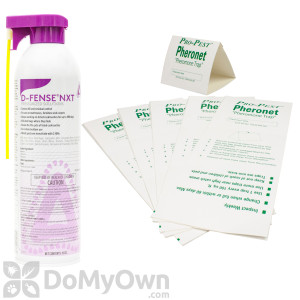Flour Moth Inspection
If you think you may have a Flour Moth or other pantry pest infestation, you will want to conduct a thorough inspection of the infested area with a good flashlight and magnifying glass. Be sure to inspect all food items, corners, and crevices in the infested area. Detection of living pests or potential larva (creamy white ‘wormlike' pests with a brown head) will indicate where to further focus your control efforts if needed.
If you are unsure if an item is infested, test it: Place it in a plastic bag where you will be able to catch anything that emerges. If you find the pantry pest accumulating in the bag, you know the foodstuff is contaminated and needs to be discarded. To insure any item is pest free, store it in these clear bags for at least a month.
Signs of Flour Moth Infestation
- Clumps in the infested food may be indicative of an Indian Meal Moth infestation. These are formed by groups of larva that are webbed together with strands of silk.
- Small Flour moths may be seen flying around kitchens, pantries or other rooms in the home in a zigzag fashion. They fly mostly at night and are attracted to lights.
- Larva (white wormlike pests with brown heads) may occasionally crawl up walls to the ceiling and suspend themselves from a silken thread.
Control Measures:
1) Non-Chemical Control
Effective as pesticides are, it is not reasonable to think they will achieve total elimination of Flour moths without any effort on your part. Practicing good sanitation and the non-chemical control techniques (eliminating conditions that favor product pests) can both speed the work of chemical control and prevent future infestations from returning.
- Remove dry pantry foods and bulk foods from original containers and store them instead in tight-fitting containers. (Pasta, cereal, flour- anything that comes in a paper or cardboard box)
- Clean pantry shelves regularly, as this will help to remove small bits of food that Flour Moths need to survive.
- Never purchase a broken or damaged package. The chance of these being infested is greater than for perfectly sealed ones.
- Do not mix old and new lots of foodstuffs. If the old material is infested, the Indian Meal Moths will quickly invade the new.
- Clean old containers before filling them with fresh food. They may be contaminated and cause a new infestation.
- Keep storage units dry. This is important because moisture favors the development of Flour Moths; dryness discourages them.
2) Moth Traps
Moth Traps represent a simple and effective solution for getting rid of Flour Moths and other product pests in kitchens, pantries, bathrooms, warehouses, and food processing plants. Pantry Pest Traps are generally constructed of cardboard or paper lined on the inside with pheromone impregnated glue strip. The insect sex pheromones powerfully attract the Flour Moths, luring them to the trap where they get stuck on the glue strip and are not able to escape. We recommend a Flour Moth Trap
3) Crack & Crevice Spray
PERMA-DUST is a residual aerosol with a crack and crevice tip that can be sprayed into the cracks and crevices of cabinets and pantries to kill Flour Moths in the adult stage. Full control requires at least 2-4 treatments spaced about 3 weeks apart, due to the life cycles of the pests.
View our entire line of Pantry Pest Control products
View our entire line of Pantry Moth Control products



